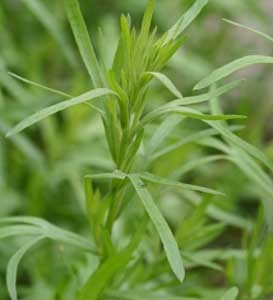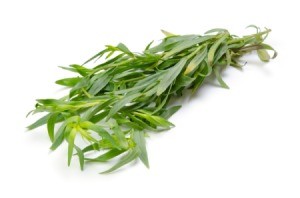
Botanical Name:
Artemisia dracunculus
Common names:
Tarragon, French Tarragon
Description:
In ancient times, tarragon was widely used to ward off dragons (dranuculus). Given the lack of dragons we see today, it's safe to assume it was highly effective. French tarragon is a thick, bushy plant with long, narrow dark green leaves that have a distinctive licorice flavor. It grows from 2-3 feet tall and rarely produces flowers. It's often confused with the lesser appealing Russian tarragon, which has larger, coarser leaves and a bitter, less pleasant flavor. When shopping for fresh tarragon, chew a leaf to confirm you're getting the correct plant.
Life Cycle:
hardy perennial
Exposure:
full sun or partial shade
Cultivation:
Tarragon likes ordinary, well-drained soil. It prefers warm, sunny growing conditions and mild winters. French tarragon rarely flowers and the seeds offered for sale are usually from the less desirable Russian tarragon. Purchase seedling and set them in the ground after the weather warms up in the spring. Tarragon is susceptible to root rot so avoid over watering.
Foliage dies back naturally in winter and can be cut back in the late fall. In colder areas, the roots need winter protection or plants can be potted and brought into a sunny location indoors. Propagation is best done by division or cuttings in the spring or fall. The roots should be lifted and divided every two years.
Propagation:
cuttings and division
Parts Used:
leaves
Harvesting and Storage:
Tarragon will not retain its flavor if dried. Snip the tips and leaves from mature stems as needed. Leaves will retain their flavor if chopped and frozen with water in ice cube trays in the freezer.
Medicinal Uses:
none
Culinary Uses
Adds flavor to poultry, mayonnaise, vegetables (especially green beans), cream and butter sauces, vinegars and salad dressings.

